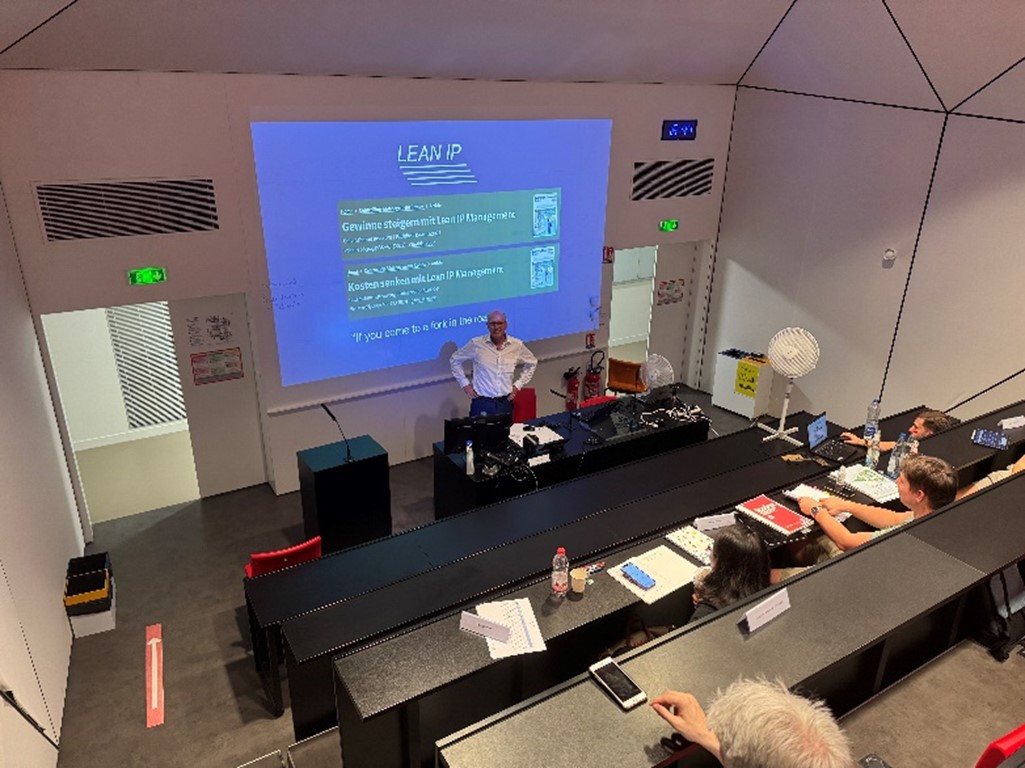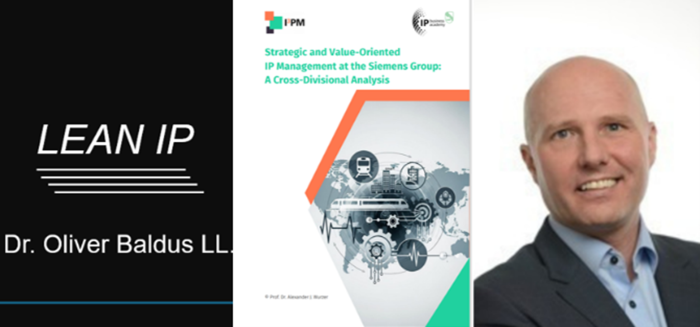Lean IP – Making IP Fit for the Real Business World Lecture by Dr. Oliver Baldus at 6th CEIPI Module MIPLM
When we think about innovation, patents often come to mind first. But patents — if managed poorly — can become just paperwork and cost centres instead of strategic assets. That’s why IP subject matter expert of the IP Business Academy Dr. Oliver Baldus’ lecture on Lean IP in the sixth module of the CEIPI MIPLM (Master of IP Law and Management) is so timely and relevant.
Rooted in the proven principles of lean production, Lean IP challenges companies to run their IP portfolios with the same rigour that manufacturers use to cut waste and boost value. The Siemens case study shows exactly how this can be done — and why it’s not just theory but daily practice in a world-leading technology company.
In this post, we’ll unpack:
- The idea behind Lean IP and how it challenges old-school patent management.
- The logic and tools Dr. Baldus outlines.
- How Siemens applies Lean IP to align its huge patent portfolio with real business value.
- Why Lean IP is more than cost-cutting — it’s a smart strategy for using IP to win markets.
The Roots of Lean: From Factory Floors to Patent Portfolios
Lean started on the factory floor. As Dr. Baldus’ slides explain, Henry Ford’s early ideas about standardization and waste reduction laid the foundation. Then the Japanese car industry — especially Toyota — turned lean into a management philosophy: only do what adds value. Anything else is waste.
John Krafcik coined the term “Lean” to describe this mindset while studying Toyota for MIT — later captured in the book The Machine That Changed the World. In a lean system, production happens just-in-time, excess inventory is eliminated, and every step must add customer value.
So, what does this have to do with patents?
The Problem with Conventional Patent Management
Dr. Baldus pulls no punches: conventional patent management is often bottom-up, inventor-driven, and focused inward. Inventors push patents because “we have to protect our ideas.” But there’s a problem: the result is massive bloat.
Did you know?
- Of today’s ~2 million active patents worldwide, 95% fail to be licensed or commercialized.
- Many patents describe interesting technology but have no practical market value.
- Only about 15% of patents ever prove relevant to the market at all.
In other words, most patents are technical “nice-to-haves” but business “dead weight.”
The “Fog of IP” — And the Need for Clarity
Baldus borrows from Clausewitz: war — and by analogy, IP strategy — is wrapped in uncertainty. But firms can’t afford IP fog. Waste is anything that doesn’t add value that the customer is willing to pay for — or that doesn’t weaken competitors or strengthen the company’s position.
A conventional approach might celebrate filing big volumes of patents. Lean IP asks tougher questions:
- Does this patent block a competitor?
- Does it help win market share?
- Does it protect revenue?
- Does it strengthen our negotiating hand with suppliers, partners, or rivals?
If the answer is “no,” the patent is waste. Just like unsold inventory on a shelf.
What is Lean IP?
 So, what exactly is Lean IP?
So, what exactly is Lean IP?
Lean IP is not just about having fewer patents. It’s about shifting from a bottom-up, inventor-driven filing frenzy to a top-down, strategy-driven IP system.
Under Lean IP:
- The company’s management — not just R&D — defines the strategic goals.
- Patents are filed to serve clear business aims: gaining market share, pressuring suppliers, securing better pricing, or blocking specific competitors.
- Patents are continuously reviewed for legal, technical, and economic quality.
- Deadweight patents — those without a clear “infringer” or market threat — are actively abandoned.
The Lean IP manager constantly asks: Is this patent adding value, blocking competitors, or helping the business reach a target?
How Lean IP Works in Practice
Dr. Baldus outlines this paradigm shift:
- Top-Down Approach: Management sets clear strategic goals. For example: “We want to win 10% market share from Competitor X.” IP is then used like a weapon: file patents to cover competitive gaps, oppose the competitor’s patents, or buy patents that strengthen the firm’s hand.
- Identify Worthless Assets: A patent with no possible infringer is worthless. If no one can copy it (or no one cares enough to copy it), it doesn’t block anyone. So it should be cleaned from the portfolio.
- Monitor Patent Scope: Every filing is checked for whether its claim scope actually supports the strategic aim. Technically obsolete patents, or those describing unnecessary details, are trimmed away.
This transforms the patent department from a cost center to a profit enabler.
Key Principles: The Three Qualities of a Lean IP Portfolio
Baldus stresses that a useful patent must have:
1️⃣ Legal Quality: It complies with patent law and is robust against challenges.
2️⃣ Substantial Quality: It truly covers what makes the product unique — not trivial or easy to design around.
3️⃣ Economic Quality: It protects something that actually makes or saves money.
Patents that score high on all three protect real competitive advantage.
Lean IP in the Real World: Siemens as a Case Study
 It’s one thing to preach Lean IP — it’s another to implement it. That’s where Siemens comes in.
It’s one thing to preach Lean IP — it’s another to implement it. That’s where Siemens comes in.
Siemens, a diversified industrial giant, consistently ranks among Europe’s top patent filers. But unlike companies that hoard patents just for numbers, Siemens has reshaped its IP strategy to align with Lean IP principles.
Let’s look at how Siemens demonstrates Lean IP in practice, based on the case study:
A Giant with a Complex Portfolio
Siemens operates in sectors as diverse as digital industries, smart infrastructure, mobility, and medical technology (Healthineers). Each division:
- Has different innovation cycles.
- Faces different competitive threats.
- Needs a tailored IP approach.
One-size-fits-all IP strategies don’t work here. So Siemens designed division-specific Lean IP systems, each aligned with the unique goals of its business unit.
Example: Digital Industries
In Siemens Digital Industries:
- Innovation happens fast — think software, AI, IoT, Industry 4.0.
- The IP team works hand-in-hand with R&D and management to file patents only for core algorithms, unique software functions, or crucial digital twins.
- Non-essential patents are avoided or abandoned.
- They use a hybrid model: some IP is patented; other know-how is kept as trade secrets to stay ahead of copycats while avoiding unnecessary disclosure.
Example: Smart Infrastructure
Siemens Smart Infrastructure builds connected energy systems and intelligent buildings. Here:
- Interoperability is crucial — open standards attract partners and grow the ecosystem.
- Siemens uses strategic patents to protect core innovations but shares certain interfaces via open platforms like the Siemens Xcelerator.
- The company actively joins standardization bodies to shape future norms and ensure its technology becomes part of industry standards — so-called Standard Essential Patents.
Example: Mobility
In Mobility (rail and transport):
- Products like high-speed trains have decades-long lifespans.
- Patents must protect key systems (like automated train control) for years.
- Safety-critical tech needs robust, enforceable IP.
- Siemens combines strong patent coverage with careful design rights and branding (trademarks) to protect the entire value of its rolling stock and solutions.
Lean IP in Action: Siemens’ Core Practices
✅ Top-Down Planning: Siemens’ IP strategy is fully tied to business goals. It’s not just about legal protection — it’s about defending market share, shaping industry standards, and driving licensing revenue.
✅ Portfolio Cleaning: Siemens actively prunes patents that no longer match its goals. Every patent must justify its upkeep fees — a clear Lean IP hallmark.
✅ Freedom-to-Operate Checks: Siemens uses robust “Freedom to Operate” analyses to avoid costly infringement battles and uncover white spaces for new patents.
✅ Monetization and Value Creation: Siemens doesn’t just file and forget. It monetizes patents through licensing, partnerships, and by leveraging them in negotiations with suppliers and rivals.
✅ Hybrid IP Strategy: Some innovations are patented. Others are guarded as trade secrets. Some parts of the ecosystem are opened to partners to encourage adoption.
✅ Standardization and Pools: In sectors like smart infrastructure, Siemens uses patent pooling and active standardization engagement to strengthen its position while keeping development lean.
Why Lean IP Matters for the Future
Dr. Baldus ends his lecture with a clear message: Lean IP isn’t just about spending less on patents. It’s about using patents — and the entire IP toolbox — as active levers to reach real strategic goals.
In Siemens’ case, that means:
- Securing sustainable competitive advantages.
- Keeping the IP department directly tied to revenue and growth.
- Ensuring every patent is defensible, valuable, and relevant.
- Creating an IP culture where “more patents” isn’t the goal — better patents are.
Takeaway: IP for the Modern Age
In an age of fast innovation, shrinking product cycles, and global competition, traditional patent hoarding doesn’t cut it anymore. Companies must:
- Think strategically.
- File selectively.
- Monitor constantly.
- Prune aggressively.
Lean IP is exactly that discipline — a toolkit for turning patents from dusty certificates into living weapons for business growth.
And Siemens shows this isn’t just theory. It’s reality.
The Big Question
Will more firms adopt Lean IP? Dr. Baldus believes so — and Siemens proves they should.
Because in today’s hyper-competitive tech world, every patent must pull its weight. If it doesn’t, it’s not lean — and it doesn’t belong.

For IP professionals and innovation leaders alike, the Lean IP mindset might just be the sharpest tool in the shed.
Here you find the presentation by IP subject matter experts of the IP Business Academy Dr. Oliver Baldus:



